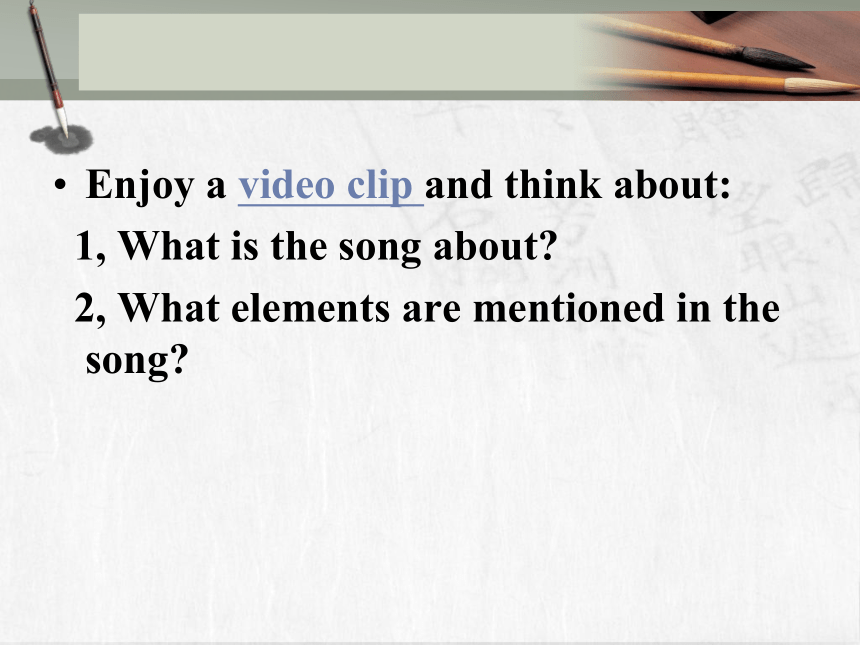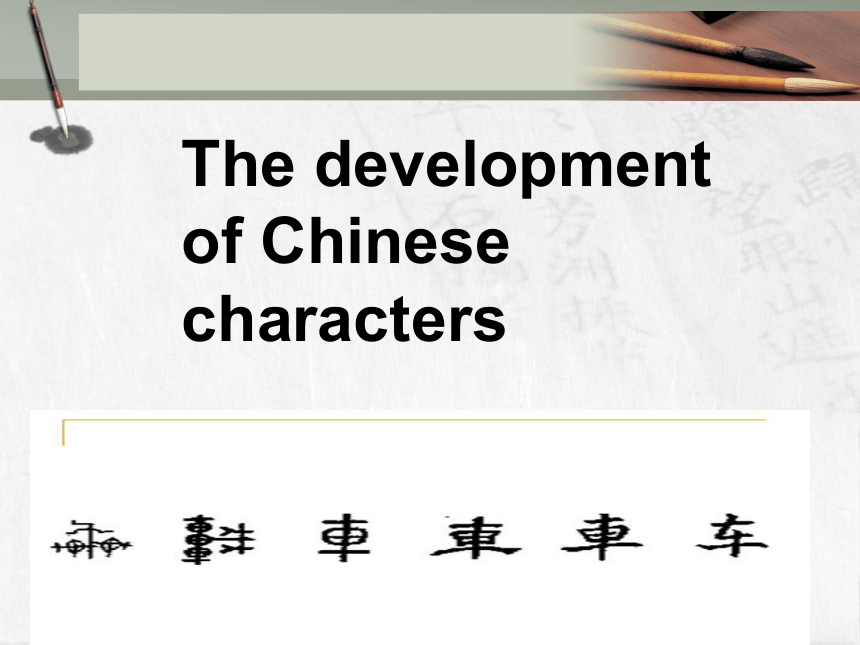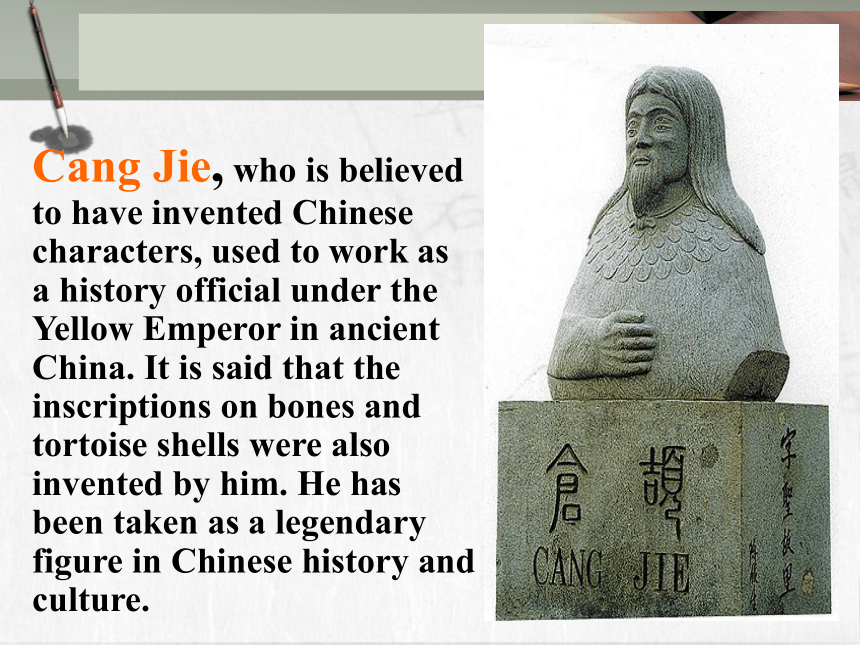2017年4月译林牛津英语模块3 Unit 2 Language Project 教学课件 (共24张PPT)
文档属性
| 名称 | 2017年4月译林牛津英语模块3 Unit 2 Language Project 教学课件 (共24张PPT) |  | |
| 格式 | zip | ||
| 文件大小 | 2.5MB | ||
| 资源类型 | 教案 | ||
| 版本资源 | 牛津译林版 | ||
| 科目 | 英语 | ||
| 更新时间 | 2017-10-01 21:22:22 | ||
图片预览









文档简介
课件24张PPT。Project Designing a bookletUnit 2Enjoy a video clip and think about:
1, What is the song about?
2, What elements are mentioned in the song? The development of Chinese charactersFast readingHow does Chinese language differ from Western languages?
2. Who first invented Chinese writing?
3.When did the Chinese government
introduce simplified Chinese
characters?
Cang JieIn the 1950sInstead of an alphabet, Chinese uses characters which stand for ideas, objects or deeds.Find out the whole structureADCBPart1(p1)--Brief introduction of
_________________
Part2(p2-4)--A story about_______ _____________________and ____ types of Chinese characters.Pare3(p5)-- ________ Chinese characters.
Cang Jie
inventing Chinese writing4SimplifiedChinese characters.
the main idea of each part
Careful reading Part1(para1)How can we study the history of the Chinese language?The history of the Chinese language can be examined by looking at how these characters developed.Origin of Chinese charactersPara 2:1.Who is thought to have invented Chinese writing?Cang JieFather of
Chinese characters?Cang Jie, who is believed to have invented Chinese characters, used to work as a history official under the Yellow Emperor in ancient China. It is said that the inscriptions on bones and tortoise shells were also invented by him. He has been taken as a legendary figure in Chinese history and culture.2. What gave him the idea to invent characters?He saw the tracks of animals in the snow and observed that the appearance of each one was different.Smart,
creative,
careful? Forms and development of Chinese characters pictographsideographs
会意字 indicatives
指事字 Picto-phonetics
形声字Characters made by combining two or more elements togetherThe form of the characters which are used to indicate directions and numbersCharacters consisting of the semantic(语意的) radical and phonetic(语音的) radical水 、月山、休 、囚上 、下、乒、乓砖、传、转Simplified Chinese charactersPara 5:What happened to Chinese characters in the 1950s?The Chinese government introduced simplified Chinese characters.Before the 1950s, Chinese characters were complicated and difficult to write.Which do you prefer?漢字擁有悠久的歷史,它是中國文化的象徵,是中國勞動人民智慧的結晶。
汉字拥有悠久的历史,它是中国文化的象征,是中国劳动人民智慧的结晶。Chinese simpleChinese complexV s.甲骨文金文战国文字小篆Oracle Bone InscriptionsBronze InscriptionsLesser Seal Characters 王曦之《兰亭序》行书楷书
Formal ScriptRunning ScriptQuestions: Is there a special language system for the blind to learn about the world? And what’s it?
Next, let’s say hello to the 2nd article—the story of Braille.Read and answer:1.Who invented Braille for the blind?
Louis Braille.
2.How long was it before Louis Braille invented ‘Braille’ after he lost his eyesight?
12 years.
3.Is the ‘Braille’ only read and only in French?
No. It can be read and written as well and nearly every language has its own version.Read and complete:When _______about reading, we think about using our eyes to see letters written or ink on paper. But nowadays, the blind can still read. It was Louis Braille ______invented ‘Braille’, who lost his eyesight at a early age as a ______ of an injury. When he went to school, the whole system of books for the blind was not ______for use. Later, in 1821, it was under the enlightenment(在…的启迪下) of the soldier that Louis Braille ______ a easy and convenient system for the blind to read.talkingthatwhoresultconvenientinventedRead and complete:The blind can easily ________ Braille with the________, and ________ with a special ________. Today, not only ______it_______ used for reading, but also it can be used to write. Besides, nearly every language, Chinese_______ ,has its own version of Braille for its people to______.recognizefingerswritetypewritercanbeincludeduseThank You!PictographA pictograph is a depiction(描绘) of a material object. SunMoonMountainSheepBull象形字 HumanWomanIdeographs 会意字 composed of two or more existing characters. A man leans against a tree, which means that he is resting.Indicatives or Self-Explanatory Characters 指事字 On the topBeneathThe left symbol means a sword.
Put a point on the character “sword”, then it refers to the blade.上下Pictophonetic形声字帽、洋、姥、驶、材、枝、钢、侣、铜 、洲
1, What is the song about?
2, What elements are mentioned in the song? The development of Chinese charactersFast readingHow does Chinese language differ from Western languages?
2. Who first invented Chinese writing?
3.When did the Chinese government
introduce simplified Chinese
characters?
Cang JieIn the 1950sInstead of an alphabet, Chinese uses characters which stand for ideas, objects or deeds.Find out the whole structureADCBPart1(p1)--Brief introduction of
_________________
Part2(p2-4)--A story about_______ _____________________and ____ types of Chinese characters.Pare3(p5)-- ________ Chinese characters.
Cang Jie
inventing Chinese writing4SimplifiedChinese characters.
the main idea of each part
Careful reading Part1(para1)How can we study the history of the Chinese language?The history of the Chinese language can be examined by looking at how these characters developed.Origin of Chinese charactersPara 2:1.Who is thought to have invented Chinese writing?Cang JieFather of
Chinese characters?Cang Jie, who is believed to have invented Chinese characters, used to work as a history official under the Yellow Emperor in ancient China. It is said that the inscriptions on bones and tortoise shells were also invented by him. He has been taken as a legendary figure in Chinese history and culture.2. What gave him the idea to invent characters?He saw the tracks of animals in the snow and observed that the appearance of each one was different.Smart,
creative,
careful? Forms and development of Chinese characters pictographsideographs
会意字 indicatives
指事字 Picto-phonetics
形声字Characters made by combining two or more elements togetherThe form of the characters which are used to indicate directions and numbersCharacters consisting of the semantic(语意的) radical and phonetic(语音的) radical水 、月山、休 、囚上 、下、乒、乓砖、传、转Simplified Chinese charactersPara 5:What happened to Chinese characters in the 1950s?The Chinese government introduced simplified Chinese characters.Before the 1950s, Chinese characters were complicated and difficult to write.Which do you prefer?漢字擁有悠久的歷史,它是中國文化的象徵,是中國勞動人民智慧的結晶。
汉字拥有悠久的历史,它是中国文化的象征,是中国劳动人民智慧的结晶。Chinese simpleChinese complexV s.甲骨文金文战国文字小篆Oracle Bone InscriptionsBronze InscriptionsLesser Seal Characters 王曦之《兰亭序》行书楷书
Formal ScriptRunning ScriptQuestions: Is there a special language system for the blind to learn about the world? And what’s it?
Next, let’s say hello to the 2nd article—the story of Braille.Read and answer:1.Who invented Braille for the blind?
Louis Braille.
2.How long was it before Louis Braille invented ‘Braille’ after he lost his eyesight?
12 years.
3.Is the ‘Braille’ only read and only in French?
No. It can be read and written as well and nearly every language has its own version.Read and complete:When _______about reading, we think about using our eyes to see letters written or ink on paper. But nowadays, the blind can still read. It was Louis Braille ______invented ‘Braille’, who lost his eyesight at a early age as a ______ of an injury. When he went to school, the whole system of books for the blind was not ______for use. Later, in 1821, it was under the enlightenment(在…的启迪下) of the soldier that Louis Braille ______ a easy and convenient system for the blind to read.talkingthatwhoresultconvenientinventedRead and complete:The blind can easily ________ Braille with the________, and ________ with a special ________. Today, not only ______it_______ used for reading, but also it can be used to write. Besides, nearly every language, Chinese_______ ,has its own version of Braille for its people to______.recognizefingerswritetypewritercanbeincludeduseThank You!PictographA pictograph is a depiction(描绘) of a material object. SunMoonMountainSheepBull象形字 HumanWomanIdeographs 会意字 composed of two or more existing characters. A man leans against a tree, which means that he is resting.Indicatives or Self-Explanatory Characters 指事字 On the topBeneathThe left symbol means a sword.
Put a point on the character “sword”, then it refers to the blade.上下Pictophonetic形声字帽、洋、姥、驶、材、枝、钢、侣、铜 、洲
